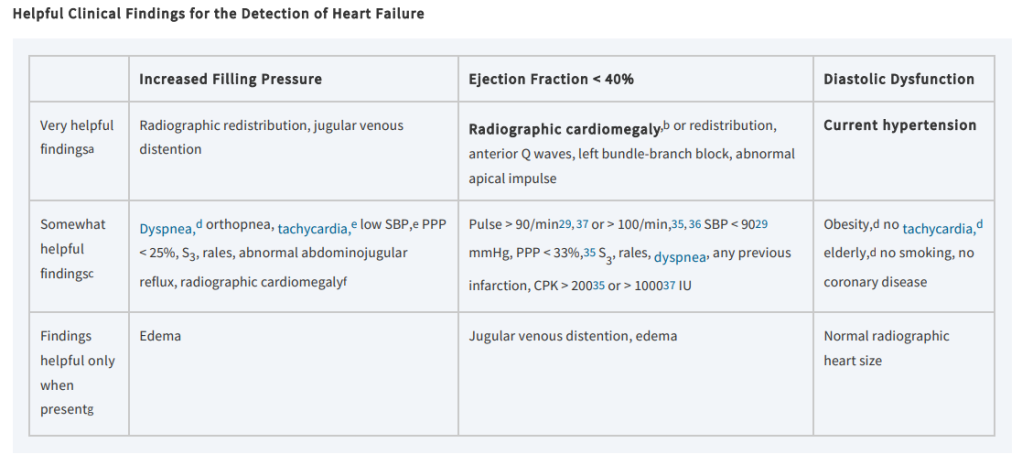The Bottom Line: “Patients with symptoms of heart failure and those with risk factors should be examined for pulmonary rales, jugular venous distention, a third heart sound, and peripheral edema and should have an ECG and chest radiograph” (Badgett)
“Very helpful findings [for detection of heart failure] are radiographic redistribution and jugular venous distention. These findings, when used alone, only help when they are abnormal and so can confirm the presence of increased filling pressure in patients with known severe systolic dysfunction. Among patients referred for consideration of cardiac transplant with a high (73%) prevalence of increased filling pressure, radiographic redistribution indicates an 80% to 90% probability and jugular venous distention, an85% to 100% probability of increased filling pressure. The absence of either finding cannot rule out increased filling pressure. In patients with lesser probabilities of increased filling pressure, such as those without known severe systolic dysfunction, isolated findings may not be useful. Somewhat helpful findings include dyspnea and abnormal vital signs. Radiographic cardiomegaly is somewhat helpful but loses its specificity after the initial detection of increased filling pressure because it can be a permanent finding and not fluctuate with changes in filling pressure. Dependent edema is helpful only when present. Edema is highly specific for increased filling pressure, although it has poor sensitivity.” (Badgett)

“Patients with heart failure can have decreased exercise tolerance with dyspnea, fatigue, generalized weakness, and fluid retention, with peripheral or abdominal swelling and possibly orthopnea. Patient history and physical examination are useful to evaluate for alternative or reversible causes. Nearly all patients with heart failure have dyspnea on exertion. However, heart failure accounts for only 30 percent of the causes of dyspnea in the primary care setting. The absence of dyspnea on exertion only slightly decreases the probability of systolic heart failure, and the presence of orthopnea or paroxysmal nocturnal dyspnea has a small effect in increasing the probability of heart failure (positive likelihood ratio [LR+] = 2.2 and 2.6).” (King)
“The presence of a third heart sound (ventricular filling gallop) is an indication of increased left ventricular end-diastolic pressure and a decreased LVEF. Despite being relatively uncommon findings, a third heart sound and displaced cardiac apex are good predictors of left ventricular dysfunction and effectively rule in the diagnosis of systolic heart failure (LR+ = 11 and 16).” (King)
“The presence of jugular venous distention, hepatojugular reflux, pulmonary rales, and pitting peripheral edema is indicative of volume overload and enhances the probability of a heart failure diagnosis. Jugular venous distention and hepatojugular reflex have a moderate effect (LR+ = 5.1 and 6.4), whereas the others, along with cardiac murmurs, have only a small effect on the diagnostic probability (LR+ = 2.3 to 2.8). The absence of any of these findings is of little help in ruling out heart failure.” (King)

“The features evaluated in more than 1 study with the highest LRs (LR > 3.5) for diagnosing heart failure were the following: the overall clinical judgment, history of heart failure, a third heart sound, jugular venous distention, radiographic pulmonary venous congestion or interstitial edema, and electrocardiographic atrial fibrillation.” (Wang)
“The features evaluated in more than 1 study with the lowest LRs (LR < 0.60) for diagnosing heart failure were the following: the overall clinical judgment, no history of heart failure, no dyspnea on exertion, the absence of rales, and the absence of radiographic pulmonary venous congestion, or cardiomegaly. The single finding that decreased the likelihood of heart failure the most was a BNP of less than 100 pg/mL (for patients with an estimated glomerular filtration rate of 15-60 mL/min/1.73 m2, a threshold of 201 pg/mL can be used). However, the clinician must always remember to first quantify and acknowledge his or her clinical suspicion according to the clinical examination before interpreting the BNP result.” (Wang)

Badgett et. al “Make the Diagnosis: Heart Failure ” in “Heart Failure.” The Rational Clinical Examination: Evidence-Based Clinical Diagnosis Eds. David L. Simel, and Drummond Rennie. McGraw-Hill Education, 2009, Full Text at Emory.
King, Michael et al. “Diagnosis and evaluation of heart failure.” American family physician vol. 85,12 (2012): 1161-8. Free Full Text.
Wang et. al “Does This Dyspneic Patient in the Emergency Department Have Congestive Heart Failure?” in “Heart Failure.” The Rational Clinical Examination: Evidence-Based Clinical Diagnosis Eds. David L. Simel, and Drummond Rennie. McGraw-Hill Education, 2009, Full Text at Emory.
